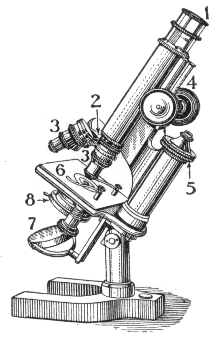Difference between revisions of "Translations:AY Honors/Microscopic Life/Answer Key/28/en"
From Pathfinder Wiki
(Importing a new version from external source) |
(Importing a new version from external source) |
||
| Line 11: | Line 11: | ||
8. diaphragm and condenser | 8. diaphragm and condenser | ||
]] | ]] | ||
| − | ;The eyepiece or ocular (1): The part of a microscope that a user looks into. | + | ;The eyepiece or ocular (1): The part of a microscope that a user looks into. It contains a lens called the ''ocular''. |
| − | ;Objective (3): The objective is another lens. | + | ;Objective (3): The objective is another lens. It is located near the specimen to be observed. |
;Body Tube: This is a hollow tube that connects the ocular lens to the objective lens. | ;Body Tube: This is a hollow tube that connects the ocular lens to the objective lens. | ||
| − | ;Nosepiece (2): The nosepiece is the part of the microscope that the objective lenses attach to. | + | ;Nosepiece (2): The nosepiece is the part of the microscope that the objective lenses attach to. Sometimes the nosepiece houses a prism whose function is to bend light from the image so that the user can sit comfortably instead of hunching over the microscope to look straight down on the specimen. |
| − | ;Stage (6): The stage is a platform where the slides are mounted. | + | ;Stage (6): The stage is a platform where the slides are mounted. |
| − | ;Diaphragm (8): The diaphragm is an apparatus located beneath the stage. | + | ;Diaphragm (8): The diaphragm is an apparatus located beneath the stage. It focuses light onto the specimen. |
;Base: The base is the bottom of the microscope on which the rest of the instrument rests. | ;Base: The base is the bottom of the microscope on which the rest of the instrument rests. | ||
| − | ;Focus knob (4 and 5): The focus knob (or knobs) adjust the distance between the ocular lens and the objective lens. | + | ;Focus knob (4 and 5): The focus knob (or knobs) adjust the distance between the ocular lens and the objective lens. This brings the specimen into focus. Microscopes often come with two focus knobs - a coarse focus and a fine focus. The coarse focus knob makes large changes in the focus. The fine focus know makes smaller adjustments. |
;Arm: The arm connects to the base and other parts of the microscope (such as the stage, diaphragm, and body tube) attach to it. | ;Arm: The arm connects to the base and other parts of the microscope (such as the stage, diaphragm, and body tube) attach to it. | ||
{{TODO|edit the picture and renumber so the parts we need are in the order presented here}} | {{TODO|edit the picture and renumber so the parts we need are in the order presented here}} | ||
Latest revision as of 06:57, 18 April 2021
- The eyepiece or ocular (1)
- The part of a microscope that a user looks into. It contains a lens called the ocular.
- Objective (3)
- The objective is another lens. It is located near the specimen to be observed.
- Body Tube
- This is a hollow tube that connects the ocular lens to the objective lens.
- Nosepiece (2)
- The nosepiece is the part of the microscope that the objective lenses attach to. Sometimes the nosepiece houses a prism whose function is to bend light from the image so that the user can sit comfortably instead of hunching over the microscope to look straight down on the specimen.
- Stage (6)
- The stage is a platform where the slides are mounted.
- Diaphragm (8)
- The diaphragm is an apparatus located beneath the stage. It focuses light onto the specimen.
- Base
- The base is the bottom of the microscope on which the rest of the instrument rests.
- Focus knob (4 and 5)
- The focus knob (or knobs) adjust the distance between the ocular lens and the objective lens. This brings the specimen into focus. Microscopes often come with two focus knobs - a coarse focus and a fine focus. The coarse focus knob makes large changes in the focus. The fine focus know makes smaller adjustments.
- Arm
- The arm connects to the base and other parts of the microscope (such as the stage, diaphragm, and body tube) attach to it.

